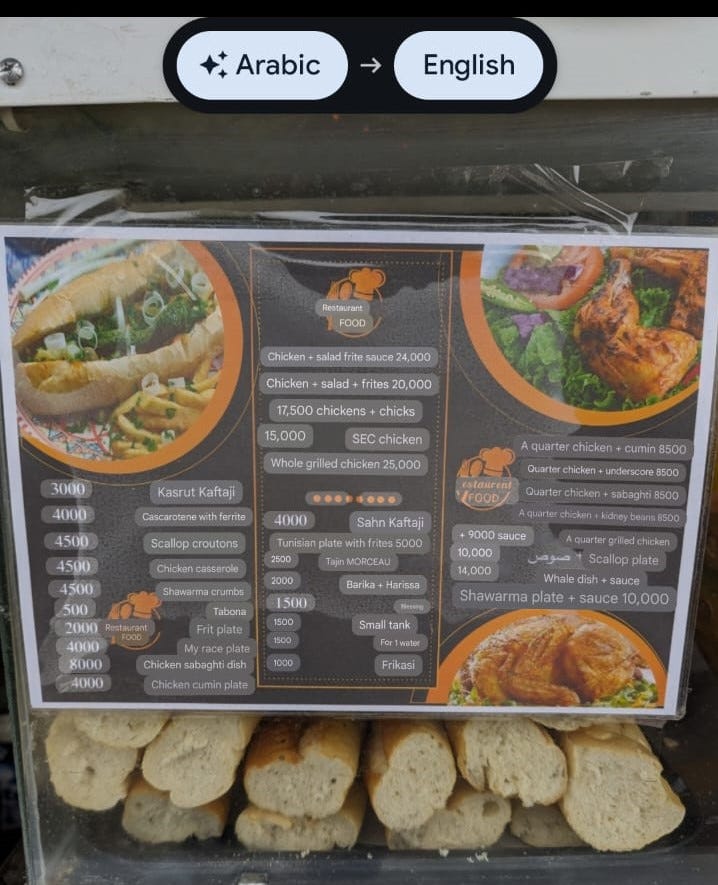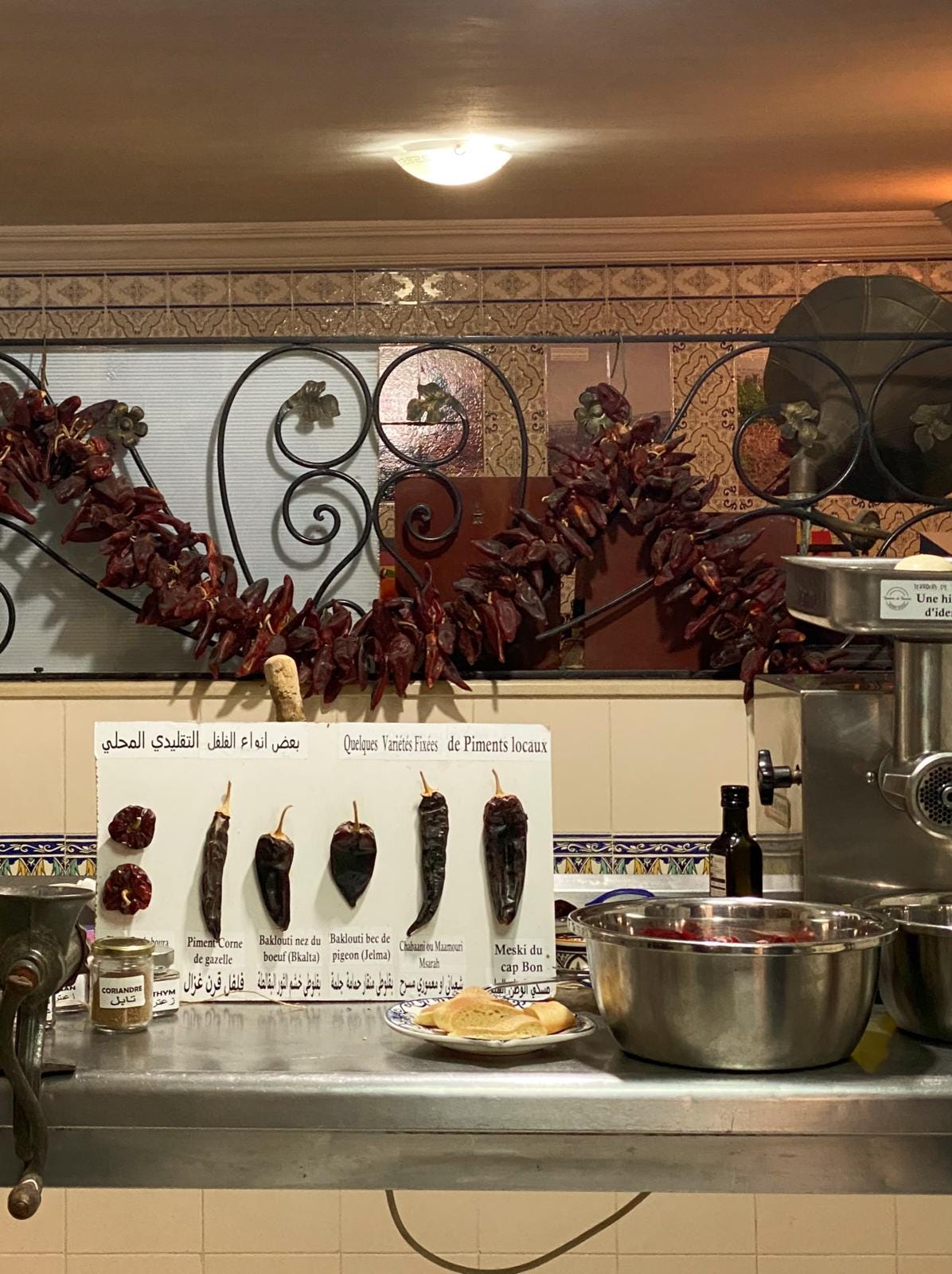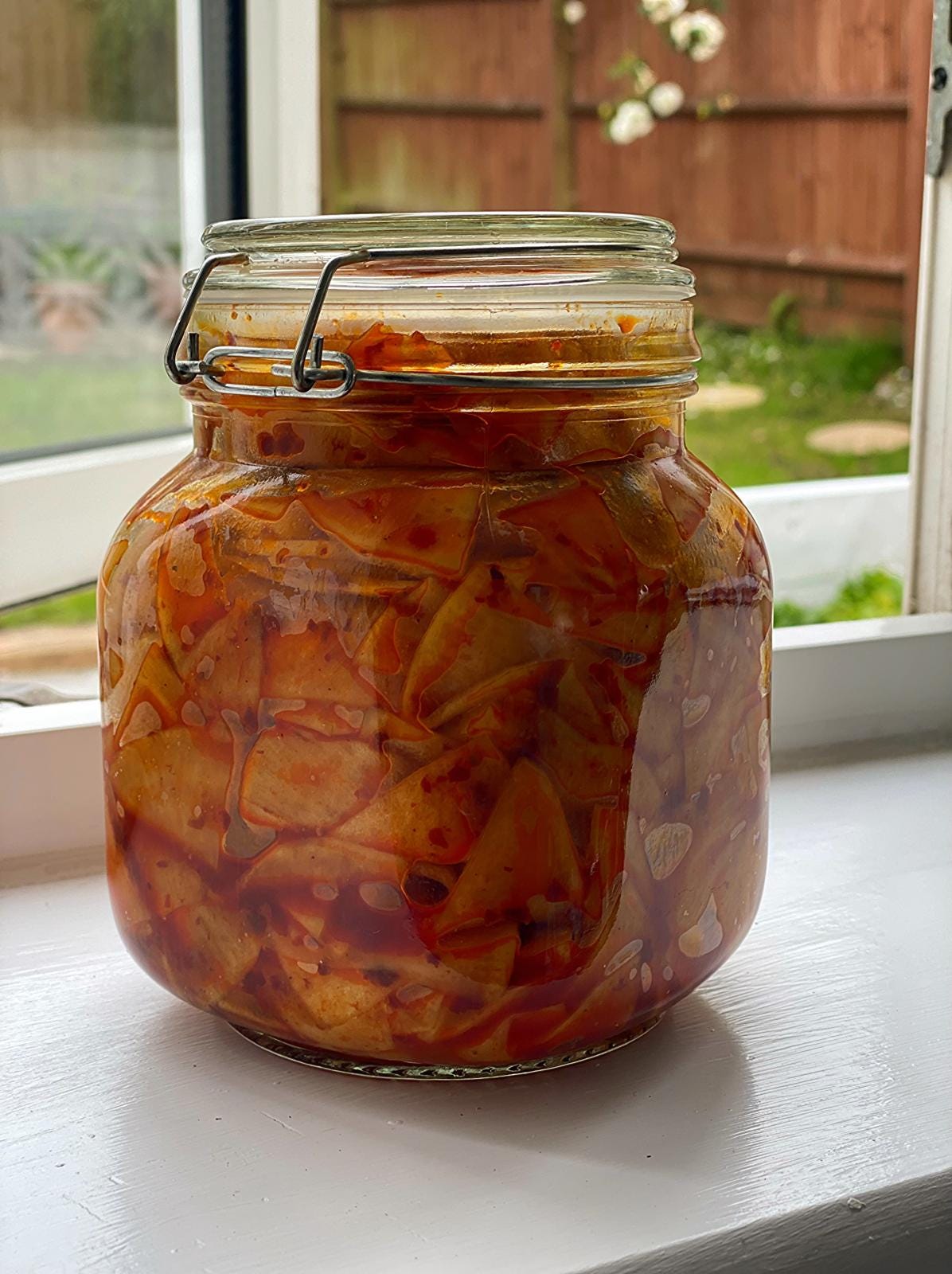Harissa is such a central part of Tunisian cuisine that I’ve been a little nervous to write this article. I hope this gives a little introduction, and some new fun facts, to this fantastic seasoning. As we head into salad season, I cannot recommend making Lamia’s torchi more highly. Spicy pickled turnips are a revelation!
Thanks, as always, for reading The Flavour Narratives. Please do reach out if you have any adventures you would like company on, and keep sharing these posts.
My eyes are closed, face turned towards the struggling air con. My rucksack leans against my legs, the palms of my hands are pressed into the top of a cool, if slightly sticky, metal table. It's been a long journey in a minibus so bumpy my watch has jubilantly declared the reaching of my 12,000 step count. We need food, and fast.
I hear a question in Arabic float across the sandwich counter where we have just ordered, past a waiting customer, to where we are sat.
I panic. It had been a mission to order in the first place, Google translate offering such delights as a small tank, quarter chicken + underscore or my race plate. We opted for a tuna sandwich.
"Fanta?" I say hopefully in response, motioning to myself and my partner across the table. The waiting customer laughs gently.
"No," she says kindly in English, "You want hot?"
I wince at my idiocy. "Shwaya shwaya, ayshek" I reply with an apologetic smile - only a little, thank you. As a harissa novice, you can never be too careful, but you can never go without.
Harissa, at base a seasoning of chilli and garlic, forms the foundation of Tunisian cuisine. Hover near a Tunisian restaurant table, potter into a home, walk into a supermarket, and harissa will appear within a foot of you. In the UK, it's an ingredient that has become a stalwart as an 'North African' easy fix for flavour. Harissa, though, is intrinsically Tunisian, so much so that it has UNESCO protected intangible heritage status.
We head to Dar Harissa, the House of Harissa, in Nabeul to learn more about this spicy seasoning. Imed Attig, producer and educator, greets us as we arrive with a fresh and firey orange juice punchy with ginger root. Our spicy journey has begun.
In the basement of Dar Harissa Imed is ready for us to make some harissa for ourselves. The name harissa, he explains, comes from the word to concasse, or roughly chop, "Just like the Italians with pesto and the…" he trails off, looking for the word, "Pestle?" offers one of the group. "Yes pestle to pesto, harasa to harissa."
At this point, he puts some dried, dark burgundy chillies into his harouss, what I would recognise as a large mortar and adds some garlic cloves. The chilies, Imed tells us, are de-seeded and soaked in water for 20 minutes so they are soft enough. One of our group uses a large mortar to break down the chillies in the bottom of the harrous until they become a paste.
"Locally," says Imed over the noise of wood on chilli on wood, "you cannot do this on a Wednesday. It is too noisy in the neighbourhood." He peers into the harrous to check on progress. "More," he encourages, "you cannot be shy!"
"The peppers are dried between July and early September. It takes 2-3 weeks in the sun for them to be ready, and then we store them on the strings ready to make the harissa in the year. There are 66 seeds for the chillies, but only 4 of them are originally Tunisian. This is why we have to protect them."
He checks on the harissa in progress again, "This is good! Now we use this to see the difference," he says, placing his hand on a meat mincing machine. He switches it on, the sounds of mechanical whirring filling the room. "We put through the same ratio of ingredients, the soaked chillies and the garlic but this time we need more to make the machine work."
As the mix is exuded from the machine three times, Imed tells us the history of harissa. A Hispanic Jewish community first bought harissa with them to the Cap Bon in the 17th century. The chillies they used were sweeter, so Tunisians took the recipe and made it spicier. Given the UK's resurgence of harissa in the last decade, it's clear that we are, as always, slow catching up to flavour.
The machine has done its work. On the table Imed presents us with the hand crushed and the machine crushed harissa. He pours a little olive oil onto the edge of each plate, and passes round pieces of bread for us to try his creations. The harissa from the harrous is smokey, spicy, and flavourful. Its cousin, from the meat mincer, is flat by comparison, its character drained of most taste beyond the sensation of spice.
"The factories make with the machines. This is why they do not taste as good. Here we make many flavours as well as this one. With ginger, rosemary, smoked chillies, fennel.” Imed serves us a feast, each dish rounded off with the telltale spice and complexity of his harissa. This is the real deal, and it's a deal that I'm willing to play dangerously to win.
Torshi - harissa pickled turnip
A few times during our Tunisian adventures we came across torshi, harissa pickled vegetables. The recipe that follows is, undeniably, one of my favourite ways to enjoy this versatile seasoning. This recipe comes from Lamia Temimi, the wonderful co-founder of Taste of Tunisia. When I came to make this, there were no turnips to be found. Instead I used swede, which was wonderful. I have also enjoyed a ‘quick pickle’ version with thinly sliced vegetables like carrot and radish. Add harissa to taste as not all harissas are made equal!
Ingredients
3 or 4 turnips
Salt (coarse or fine it doesn’t matter)
1 tbsp harissa arbi (or canned harissa)
1 or 2 tbsp of vinegar
Olive oil
Preparation
Start by washing the turnips well
Cut the turnips into very thin, almost transparent slices (2 millimeters).
Put them in a bowl and sprinkle them with salt in layers (a layer of salt and a layer of turnips).
Finish with a layer of salt.
Cover and refrigerate overnight (8 to 12 hours).
Remove the bowl from the refrigerator and rinse the turnip slices several times. They will become all soft and will have released a lot of water.
Wring them in your hands to remove as much water as possible.
In another container mix the harissa and vinegar.
Add to turnips and mix well.
Add a drizzle of olive oil and mix again.
Enjoy!
Sawa Taste of Tunisia
Most of my Tunisian culinary adventures were enjoyed with Sawa Taste of Tunisia Tours. These are foodie tours with a difference - leading with family and women run, ecologically conscious businesses often off of the beaten track.
Website - sawataste.com/eng/
Instagram - @sawatasteoftunisia
Facebook - https://www.facebook.com/profile.php?id=61553069023239









